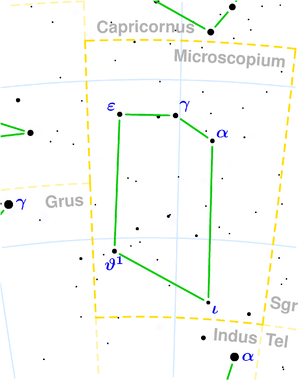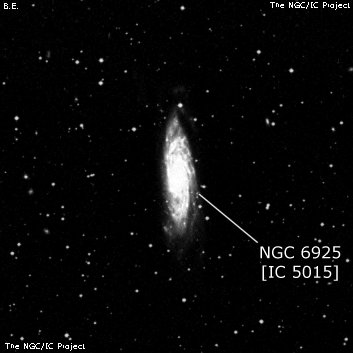 A small and faint constellation in the southern sky, a faint group of a few stars between the Piscis Austrinus and Sagittarius, down below Capricornus. In our area, only its northern part rises above the horizon in late summer evenings. The microscope lies in a star-poor region of the sky, and none of its stars is brighter than 4.7mag. It contains no more than a few rather attractive binaries and a handful of faint galaxies.
A small and faint constellation in the southern sky, a faint group of a few stars between the Piscis Austrinus and Sagittarius, down below Capricornus. In our area, only its northern part rises above the horizon in late summer evenings. The microscope lies in a star-poor region of the sky, and none of its stars is brighter than 4.7mag. It contains no more than a few rather attractive binaries and a handful of faint galaxies.
γ Mic - The brightest star of the constellation. It has an apparent magnitude of only 4.71. It used to belong to the constellation Southern Fish as the star 1 Piscis Austrini. It is located 220 light-years away from the Sun. It is a yellow star of the G8 spectral class, which has a companion with a brightness of 13.7 mag at a distance of 26".
θ Mic - A triple star system consisting of a close pair of components with magnitudes 6.4 and 7, separated by a distance of 0.5", which is a good test for a 250mm telescope. Higher magnification and stable atmospheric conditions are necessary to see this close pair of yellow stars as at least two disks in contact. 78.4" away from this close pair, there is another star of magnitude 11.
α Mic - It is not the brightest star in the constellation. This object belongs to the G6 class, so we can expect its yellow color. Its brightness is 5mag and at a separation of 20.5", we can see gray-white companions of magnitude 10 in the telescope. It is located 380 light-years away.
Dunlop 236 - beautiful wide pair (57.4") of two nearly equally bright stars (6.5mag and 6.9mag) suitable for binoculars and small telescopes.
NGC 6925

John Herschel discovered NGC 6925 = h3834 on 31 Jul 1834 and recorded "B; mE; pslbM; 2 1/2' l, 40" br." His mean position (3 observations) is accurate.
Harold Corwin suggests that Lewis Swift's XII-20 (later IC 5015), found on 18 Aug 1897, may be a duplicate observation. He feels Swift's description "pB, pS, R, nearly bet 2 st with dist. companion" is a reasonable fit, though the position is poor (typical for those made in 1897). But I would be surprised if Swift called this galaxy "pretty small" as well as "round", and his position is well off in both RA (6 minutes of time) and Dec (17'), so I've listed it as not found.
200/250mm - 8" (7/16/82): very faint, elongated SW-NE.
400/500mm - 17.5" (8/5/91): moderately bright, fairly large, edge-on 4:1 SSW-NNE, 3.0'x0.8', thin long arms extend from the core. A mag 13 star is at the north tip 1.4' from center.
Notes by Steve Gottlieb